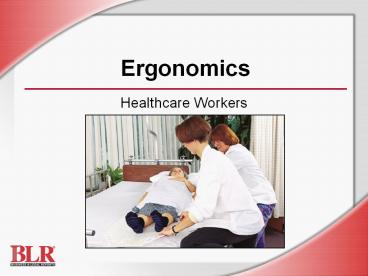Ergonomics - PowerPoint PPT Presentation
Title:
Ergonomics
Description:
Ergonomics Healthcare Workers Session Objectives You will be able to: Identify ergonomic risk factors in your job Recognize musculoskeletal disorders (MSD) signs and ... – PowerPoint PPT presentation
Number of Views:859
Avg rating:3.0/5.0
Title: Ergonomics
1
Ergonomics
- Healthcare Workers
2
Session Objectives
- You will be able to
- Identify ergonomic risk factors in your job
- Recognize musculoskeletal disorders (MSD) signs
and symptoms - Lift and carry objects safely
- Take other precautions specific to your job to
prevent ergonomic injuries
3
What You Need to Know
- What ergonomics is and why it is important
- What MSDs are and how you could be at risk
- Symptoms of injuries and what to do about them
- Safe lifting technique
- Ergonomic safety precautions for each task you
perform on the job
4
What Is Ergonomics and Why Is It Important?
- Ergonomics fits jobs to people
- It helps prevent injuries
5
Musculoskeletal Disorders
- MSDs involve injuries to
- Muscles
- Nerves
- Tendons and ligaments
- Joints
- Cartilage
6
Major Risk Factors
- Repetition
- Force
- Awkward postures
- Contact stress
- Vibration
7
MSD Hazards on the Job
- Housekeeping, laundry, and food service
- Patient care
- Maintenance
- Central supply
- Office
8
MSD Signs and Symptoms
- Back and neck shooting pain, stiffness
- Shoulders pain, stiffness, loss of mobility
- Arms and legs shooting pain, numbness
- Elbow and knee joints pain, swelling, stiffness
9
MSD Signs and Symptoms (cont.)
- Hands and wrists pain, swelling, numbness
- Fingers pain, loss of strength or mobility
- Thumbs pain at the base
- Feet and toes numbness, stiffness, burning
sensation - Be sure to report any signs or symptoms of MSDs
to your supervisor right away and seek prompt
medical treatment
10
Basic MSD PreventionSafe Lifting Technique
- Plan your lift
- Stand close to the load
- Squat down
- Get a firm grasp
- Lift with your legs
- Keep the object close to your body
11
Basic MSD PreventionSafe Lifting Technique
(cont.)
- Carrying
- Unloading
12
MSD Risks and Basic Prevention
- Do you understand the information presented so
far?
13
Planning Patient Lifts
- Get help if necessary
- Stretch briefly
- Select the method and equipment youll use
- Lock the bed or chair
- Decide on your route
- Explain your plan to the patient
14
Lifting Patients Safely
- Helping patients
- Sit up in bed
- Stand up
15
Lifting Patients Safely (cont.)
- Helping patients
- Sit down
- Get up from the floor
16
Lifting Patients Safely (cont.)
- Bed to chair, chair to bed, or chair to chair
- Lateral transfer
17
Lifting Patients Safely (cont.)
- Chair to exam table
- Repositioning in bed
18
Handling Carts Safely
- Place heavy and frequently used items within easy
reach - Remove unnecessary items
- Balance loads
- Push, dont pull
19
Transporting Portable Equipment
- Rolling devices
- Obstacles
- Medical equipment
- Oxygen tanks
20
Managing Liquid Transfers
- Housekeepers should
- Use buckets with casters
- Use a hose to fill buckets
- Make sure casters roll easily
- Use proper lifting technique to empty buckets
- Get help emptying buckets if necessary
21
Managing Liquid Transfers (cont.)
- Kitchen workers should
- Use proper lifting and carrying techniques
- Use elevated faucets or hoses to fill large pots
with water - Use ladles or saucepans to empty pots
- Get help lifting or shifting heavy pots and pans
22
Selecting and Using Hand Tools to Prevent Injury
- Make sure handle fits your grip
- Use firm but comfortable grip
- Choose the lightest tool
- Select tools that have minimal vibration
- Keep tool blades sharp
23
Handling Heavy Bags
- Use a materials handling device
- Slide bags on and off carts
- Get help lifting large, heavy bags
24
Loading and Unloading Laundry
- Handle only a few items at a time
- Brace your body against the machine when lifting
- Brace with one hand, while using the other to
pull knotted items free - Use a cart to transport heavy baskets or bags
25
Housekeeping Precautions
- Use carts to transport supplies
- Avoid bending or twisting
- Alternate tasks
- Clean objects at waist level whenever possible
- Push with the leading edge when dusting
- Work spray triggers with index and middle fingers
26
Housekeeping Precautions (cont.)
- Mopping and sweeping
- Kneeling
- Scrubbing
- Vacuuming
27
Sit Properly to Reduce Strain on Your Back
- Sit up straight
- Lean back
- Keep your chair close to the work surface
- Turn with your whole body
- Hold paperwork upright
28
Sit Properly to Reduce Strain on Your Back (cont.)
- Adjust your chair and work surface
- Arrange your work area to minimize reaching and
bending - Position your computer correctly
- Maintain a neutral position while keyboarding
- Change positions regularly
29
Preventing Ergonomic Injuries on the Job
- Do you understand the information about
preventing ergonomic injuries?
30
Take Good Care of Your Back
- Wear proper shoes
- Practice good posture
- Get regular exercise
- Sleep on a firm mattress
- Try to keep your weight down
- Dont overexert
31
Dont Ignore Back Problems or Other Injuries
- Tell your supervisor
- Seek medical treatment
- Follow your doctors advice
32
Key Points to Remember
- Make sure you can recognize MSD symptoms
- Be aware of ergonomic risk factors
- Take proper precautions to prevent injuries
- Report any symptoms immediately and seek medical
treatment































